T ERROR IN THE C ITY OF C HAMPIONS
A LSO BY T OM S TANTON
The Final Season The Road to Cooperstown Hank Aaron and the Home Run That Changed America Ty and The Babe
T ERROR IN THE C ITY OF C HAMPIONS
Murder, Baseball, and the Secret Society That Shocked Depression-Era Detroit
T OM S TANTON

An imprint of Rowman & Littlefield
Distributed by NATIONAL BOOK NETWORK
Copyright 2016 Tom Stanton
All rights reserved. No part of this book may be reproduced in any form or by any electronic or mechanical means, including information storage and retrieval systems, without written permission from the publisher, except by a reviewer who may quote passages in a review.
British Library Cataloguing in Publication Information Available
Library of Congress Cataloging-in-Publication Data
Names: Stanton, Tom, 1960 author.
Title: Terror in the city of champions : murder, baseball, and the secret society that shocked Depression-era Detroit / Tom Stanton.
Description: Guilford, Connecticut : Lyons Press, 2016. | Includes bibliographical references and index.
Identifiers: LCCN 2015043482 (print) | LCCN 2016005240 (ebook) | ISBN 9781493015702 (hardcover : alk. paper) | ISBN 9781493018185 (ebook) | ISBN 9781493018185 (e-book)
Subjects: LCSH: MurderMichiganDetroitHistory20th century. | Black Legion. | Professional sportsMichiganDetroitHistory20th century. | BaseballMichiganDetroitHistory20th century. | Detroit (Mich.)History20th century.
Classification: LCC HV6534.D6 S73 2016 (print) | LCC HV6534.D6 (ebook) | DDC 364.152/30977434dc23
LC record available at http://lccn.loc.gov/2015043482
 The paper used in this publication meets the minimum requirements of American National Standard for Information SciencesPermanence of Paper for Printed Library Materials, ANSI/NISO Z39.48-1992.
The paper used in this publication meets the minimum requirements of American National Standard for Information SciencesPermanence of Paper for Printed Library Materials, ANSI/NISO Z39.48-1992.
For my sister Janis Stanton-Peterson, who gave me my first typewriter and so much more
C ONTENTS
This is the Detroit of the Detroiters: first, of course, the automobile capital of the world... then, the city of championsJoe Louis, the Tigers, the Redwings... the parish of the priest with the largest congregation ever... the financial center that produced the most prodigious banking crash of the Depression... the city that calls itself Detroit the Dynamic. A UTHOR J AMES S TEVENS IN T HE A MERICAN M ERCURY , N OVEMBER 1935

The Black Legion probably is the craziest and most dangerous mob ever formed in the United States. Police are not fighting gangsters. We are fighting a low type of mentality, men easily incited by mob psychology, who have taken a silly pledge and gone through a crazy ritual apparently created by a fanatic who seeks power. D ETROIT P OLICE I NSPECTOR J OHN A . H OFFMAN, M AY 1936
P ROLOGUE
When I was a boy in the early 1970s, my aunts and uncles came to our house every December for the annual family holiday celebration. Amid clouds of cigarette smoke, the basement aglow with Christmas lights, they reminisced about their early years in Detroit. I heard of a magical time when even personal tragediesthe deaths of two infant sisters, the funeral of a grandfather, the slow demise of pal Beeziewere rendered soft and sweet. Most of their stories related to family: Aunt Bernice singing with a Big Band, Uncle Herbie leading a pack of neighborhood toughs, Uncle Teddy taking a church parishioners car for a joy ride.
My father and his brothers had been athletes, playing on sandlots, outdoor rinks, and cemetery football fields. They captivated me with their tales of the triumphant teams and heroes of their younger days. In the 1970s only one team I followed came close to winning anything. But my dad and uncles evoked an enchanted era of nonstop triumphs. Mickey Cochrane, Charlie Gehringer, Hank Greenberg, Schoolboy Rowe, Joe Louis, Dutch Clark, Normie Smiththe names danced from their youthful hearts. Within a six-month period in 1935 and 1936, the Tigers, Red Wings, and Lions all captured titles as Detroits own Joe Louis reigned as boxings uncrowned champion. Detroit remains the only city to score the trifecta of a World Series, a Stanley Cup, and an NFL championship in one season. The fact that it happened during the Depressionwhen my grandfather was unemployed, the family risked losing its home, and the children subsisted on watery soups and bacon-grease sandwichesonly added to its mystical significance. That it took place in a Detroit that was no longer recognizable made it all the more enticing. Through the eyes of a boy, it seemed a glorious time to be alive, a Little Rascals episode of endless escapades.
And it was at a family gathering that I first heard of the Black Legion. Clements Maximilian Stone was the eldest of my fathers nine siblings, one of several who changed his last name from Stankiewicz. On a summer evening in 1936, Clem was walking near Hastings Street in Detroits black district with his brother Bucky and two friends. They were white, left-leaning, aspiring writers and artists in their early twenties. Their presence in jazzy Paradise Valley spoke to their progressive nature, their sense of adventure, and, likely, their desire to score reefer. As they made their way down a side street, a car carrying two men slowed beside them. A white man in the drivers seat asked why they were in the neighborhood.
Whats it to you? said Bucky, feisty and fierce.
You dont belong here, the guy answered.
In Uncle Clems retelling, Bucky tensed his meaty biceps, raised his bulldog shoulders, and stepped toward the car.
Who the hell are you? he snapped.
The driver flashed a police badge. Bucky, already a veteran of several protest marches, had heard rumors of activists being abducted and killed. He didnt believe the men were actually copsthey were in street clothes and their car was unmarkedso he barked out a challenge. The two men pulled revolvers and ordered the four into the backseat. As the car sped off, Clem imagined the two gunmen to be Black Legion night riders. Clem thought he and his comrades were heading to a bloody end. Instead, they wound up at a police precinct, where they spent a night in jail, angry but relieved to have not encountered the Black Legions infamous thugs. In his 1970s recitation my uncle provided only the vaguest sense of the organization, enough to intrigue but not terrify an eleven-year-old.
Most of my uncles died years back. In the seasons that followed, while researching other books, I would occasionally stumble upon references to the Black Legion and the true, horrific, nonromanticized, adult version of the secret society would come into focus. With tens of thousands of members across the Midwest, the legion harbored grand, sinister ambitions.
Its eventual exposureand the revelation that its tentacles reached into police forces, court systems, and elected officesspawned hysteria. Neighbors turned on neighbors. Officials selectively purged public payrolls of accused members. Terrified citizens flooded J. Edgar Hoover with demands for action. For months the legion dominated page one, even prompting a Humphrey Bogart movie.
The rise and fall of the Black Legion paralleled, intersected, and overlapped that of the City of Champions. One of Detroits darkest hours became entangled with one of its grandest. Much of this story has faded into history, passing with the men and women who lived it. Some of it has never been told until now.
Next page
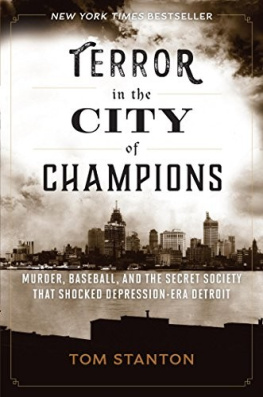

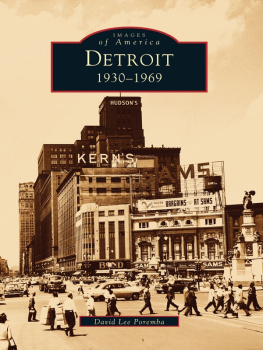
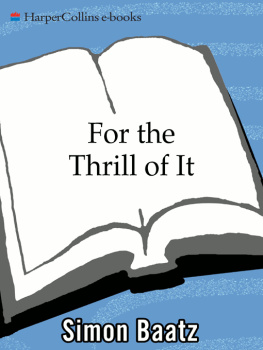

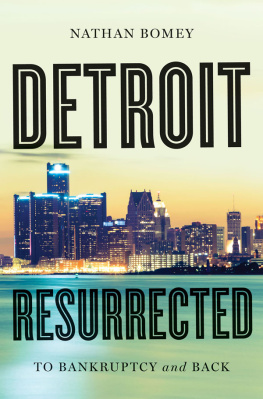

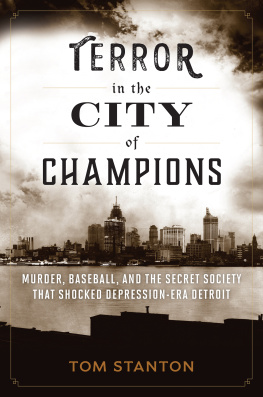
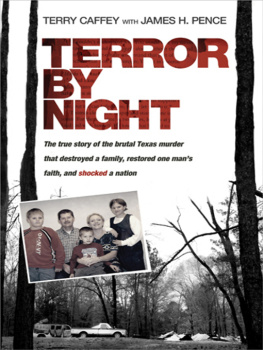

 The paper used in this publication meets the minimum requirements of American National Standard for Information SciencesPermanence of Paper for Printed Library Materials, ANSI/NISO Z39.48-1992.
The paper used in this publication meets the minimum requirements of American National Standard for Information SciencesPermanence of Paper for Printed Library Materials, ANSI/NISO Z39.48-1992.